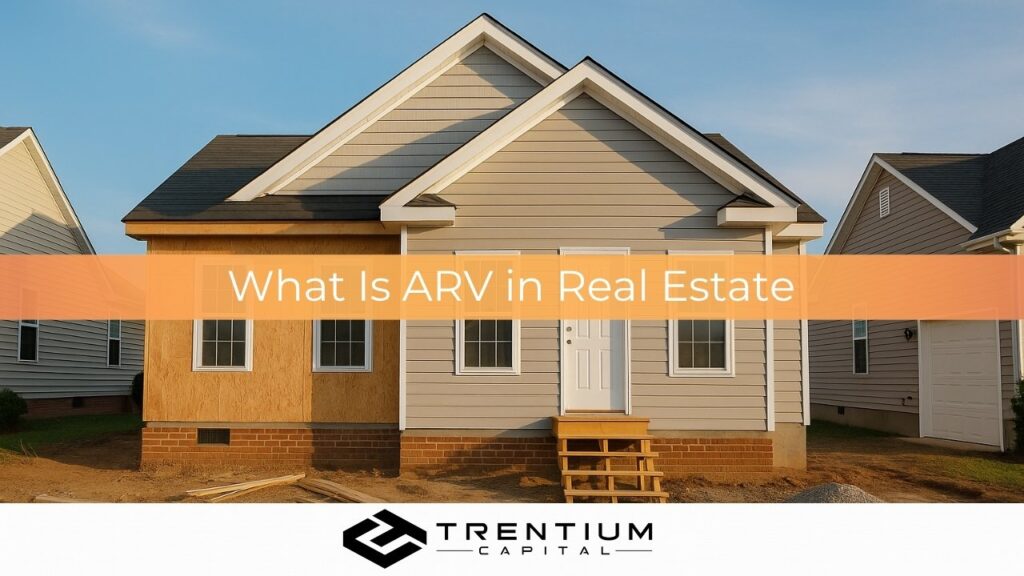Whether you’re a seasoned flipper or a first-time investor, knowing the true value of a property post-renovation could be the difference between profit and loss. That’s where ARV comes in; mastering it is necessary for real estate success.
In real estate investing, especially for fix-and-flip or BRRRR strategies, the Repair Value (ARV) is a critical number. It helps determine how much you should pay for a property, what kind of renovations make financial sense, and whether you’ll attract financing. Yet, many new investors overlook it or miscalculate it. In this in-depth guide, we’ll explain exactly what ARV is, why it matters, how to calculate it correctly, and how to use it to fund profitable deals, especially with financing options from Trentium Capitals.
What Is ARV in Real Estate?
ARV, or After Repair Value, refers to the estimated market value of a property after it has been fully renovated or improved. It tells you what a property will be worth once it’s brought up to modern standards or is in comparable condition to other updated properties in the area. Consider ARV as the future market value of a distressed or outdated home after it’s been flipped.
Why It Matters:
- It helps investors determine how much they can pay for a property.
- It guides lenders in deciding how much to fund.
- It estimates potential profit before a purchase is made.
In short, ARV is the foundation of smart real estate investing.
Why Is ARV Important for Real Estate Investors?
ARV isn’t just a guess. The benchmark drives critical decisions, especially in fix-and-flip or value-added projects. Here’s why it matters:
Profit Calculation:
ARV allows you to estimate your gross profit margin. Subtract your purchase price, rehab costs, and holding costs to determine potential ROI.
Financing Approval:
Most hard money and real estate lenders (like Trentium Capitals) use ARV to calculate the funding they can offer, often up to 70% of ARV.
Deal Analysis:
If the ARV doesn’t justify your renovation budget and purchase price, it’s a red flag to walk away.
Appraisal Value:
A strong ARV supported by solid comparables (comps) makes appraisals smoother and more accurate.
How to Calculate ARV in Real Estate (Step-by-Step)
To calculate ARV, you’ll need two main pieces of information:
- The expected market value of comparable properties (comps) after renovations.
- A realistic assessment of the repairs or upgrades planned.
Here’s the basic ARV formula:
ARV = Property’s Purchase Price + Value of Renovations
However, this simplified formula is only a rough starting point. A more accurate and industry-standard approach is:
Let’s break it down:
Step 1: Find Comparable Properties (Comps)
Look for 3–5 similar properties that:
- Are you in the same neighborhood or school district
- Have identical square footage and layout
- Were sold in the last 3–6 months
- They are in renovated condition
Use tools like:
- MLS access (Multiple Listing Service)
- Zillow, Redfin, Realtor.com
- Public property records
- Real estate agents
Step 2: Estimate Renovation Scope & Costs
Calculate how much work is required to bring your property to the level of the comps. This may include:
- Kitchen and bathroom upgrades
- Roof or HVAC replacement
- Flooring, paint, or curb appeal improvements
Use contractor bids, experience, or remodeling calculators for accurate estimates.
Step 3: Apply the 70% Rule (Optional)
Many investors use the 70% rule to ensure profitability. This rule suggests you should never pay more than 70% of the ARV minus rehab costs.
Formula:
Max Purchase Price = (ARV × 70%) – Repair Costs
Example:
- ARV = $300,000
- Estimated Repairs = $50,000
Max Purchase Price = (300,000 × 0.7) – 50,000 = $160,000
This rule keeps you from overpaying and builds a safety margin for unexpected expenses.
Common Mistakes When Estimating ARV
1. Using outdated comps:
Always use recent sales. The market changes fast, especially in hot or declining areas.
2. Comparing to properties too far away:
Even a few blocks can mean a different school district, drastically affecting value.
3. Overestimating rehab impact:
Just because you added granite doesn’t mean the house will sell at the top of the market.
4. Ignoring market shifts:
Rising interest rates or market slowdowns can affect the final sale price. Always plan conservatively.
Tools & Resources for ARV Estimation
- Zillow / Redfin “Sold Homes” filters
- PropStream / BatchLeads for comp data
- REI calculators or ARV spreadsheets
- Licensed appraisers or agents for valuation support
Combining digital tools with expert guidance yields the most accurate ARV for serious investors.
ARV and Real Estate Financing: Why Lenders Care
Hard money lenders and bridge loan providers base their loan amount on ARV, not the purchase price. This gives you more leverage.
For example, Trentium Capitals provides loans up to 70–75% of ARV, which means:
- You need less upfront capital
- You can scale faster
- You reduce risk while increasing opportunity
ARV also influences:
- Loan-to-Value Ratio (LTV)
- Loan-to-Cost Ratio (LTC)
- Exit strategy planning
A strong, data-backed ARV makes your deal more attractive to lenders and partners.
Real-Life Example: ARV Calculation for a Fix-and-Flip
Let’s say you’re eyeing a distressed home for $180,000. After walking the property and consulting with a contractor, you estimate $50,000 in renovations.
You find four comparable homes within a half-mile radius that recently sold for:
- $310,000
- $315,000
- $305,000
- $320,000
Step 1: Average Comps Sale Price
($310k + $315k + $305k + $320k) / 4 = $312,500 ARV
Step 2: 70% Rule Check
Max Purchase Price = (312,500 × 0.7) – 50,000 = $168,750
Since your purchase price is $180,000, this might be too risky unless you can lower rehab costs or negotiate a better price.
Final Thoughts:
ARV isn’t just a number. It’s the blueprint for your entire investment strategy. Everything hinges on understanding and estimating ARV correctly, from acquisition to rehab to resale or refinancing. Never skip this step, whether flipping, wholesaling, or applying BRRRR.
Need Funding for Your Project?
Trentium Capital is your trusted partner in real estate lending. We offer fast, flexible financing options for investors ready to act on high-ARV properties.



